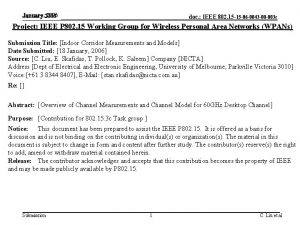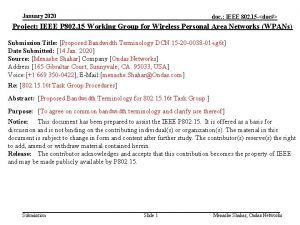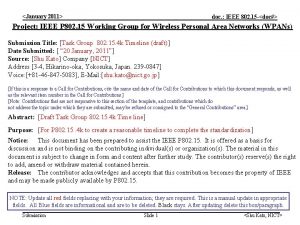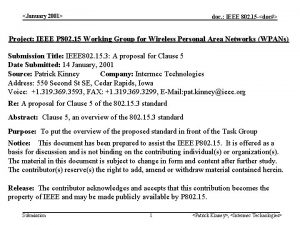January 2018 doc IEEE 802 11 180490 r







- Slides: 7

January 2018 doc. : IEEE 802. 11 -18/0490 r 0 Ultra Short Range Channel Date: 2018 -03 -01 Authors: Submission Slide 1 Assaf Kasher, Qualcomm

January 2018 doc. : IEEE 802. 11 -18/0490 r 0 Abstract This presentation discuss channel access for Ultra Short Range (scenario) as resolution to CID 1084. Submission Slide 2 Assaf Kasher, Qualcomm

January 2018 doc. : IEEE 802. 11 -18/0490 r 0 CID 1084 As there is a close proximity use case, to As in comment. achieve it, mechanism of determining carrier sense level according to transmission power, i. e. , when transmission power is lower then carrier sense level is higher, should be included somewhere in section 10. Submission Slide 3 Assaf Kasher, Qualcomm

January 2018 doc. : IEEE 802. 11 -18/0490 r 0 Discussion • What is “close proximity” or “Ultra Short Range”? • We propose that this is limited to transmissions within a range of 10 cm (D 1). • What change is needed in Channel Access rules? • We propose that if the device does not create significant interference at a ragne of 30 cm (D 2), it may ignore channel access rule (i. e it may transmit even when there is NAV or active packet on the medium). Submission Slide 4 Assaf Kasher, Qualcomm

January 2018 doc. : IEEE 802. 11 -18/0490 r 0 What is significant interference • We propose that significant interference will be defined as causing interference of 3 d. B below MCS 1 sensitivity at range of 30 cm. • This means that the EIRP of TX in this case is limited to -13. 5 d. Bm • This mean that device at 10 cm receives at most -65 d. Bm • This would limit the rate in USR to MCS 8 (1. 925 Gbs) • This rate may be too low • We can fix that by either reducing D 1 (e. g. to 5 cm) or increasing D 2 Submission Slide 5 Assaf Kasher, Qualcomm

January 2018 doc. : IEEE 802. 11 -18/0490 r 0 Options for Resolution • Add an exception to channel access rules: • “If the EIRP of the Transmitter is below -13 d. Bm (resulting in a level of 3 d. B below MCS 1 at a range of 30 cm), a STA may initiate transmission even if PHY-CCA. indication(busy) or NAV is active” • Reject the comment • Modify the numbers (30 cm, -13 d. Bm) • Adapt the CCA sensitivity to TX-Power/EIRP Submission Slide 6 Assaf Kasher, Qualcomm

January 2018 doc. : IEEE 802. 11 -18/0490 r 0 References Submission Slide 7 Assaf Kasher, Qualcomm












